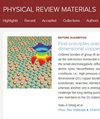Accuracy of metaGGA functionals in describing transition metal fluorides
IF 3.4
3区 材料科学
Q2 MATERIALS SCIENCE, MULTIDISCIPLINARY
引用次数: 0
Abstract
Accurate predictions of material properties within the chemical space of transition metal fluorides (TMFs), using computational frameworks such as density functional theory (DFT), is important for advancing several technological applications. The state-of-the-art semilocal exchange-correlation functionals within DFT include the strongly constrained and appropriately normed (SCAN) and the restored regularized SCAN (), both of which are meta generalized gradient approximation (metaGGA) functionals. Given their semilocal nature, both SCAN and are susceptible to self-interaction errors (SIEs) while modeling highly correlated electrons of transition metals. Hence, in this work, we evaluate the accuracy of both SCAN and functionals in estimating several properties of TMFs, including redox enthalpies, lattice geometries, on-site magnetic moments, and band gaps. Specifically, we consider binary fluorides of Ti, V, Cr, Mn, Fe, Co, Ni, and Cu. We observe both SCAN and exhibit poor accuracy in estimating fluorination enthalpies among TMFs, which can be primarily attributed to SIEs among the electrons, given both functionals bind accurately. Thus, we derive optimal Hubbard corrections for both functionals based on experimental fluorination (or oxidation) enthalpies within binary TMFs. Note that our attempts at using the linear response theory to derive corrections yielded unphysical values for V, Fe, and Ni fluorides. While adding the fluorination-enthalpy-derived corrections to the metaGGA functionals does not significantly affect the lattice volumes and on-site magnetic moments (and in turn, the accuracy of these property estimations versus experiments), it does cause a significant increase in calculated band gaps. Note that the -corrected band gaps in several fluorides deviate to a lesser extent from band gaps calculated with a hybrid functional compared to the non--corrected functionals. Also, we calculated the average Na intercalation voltage in Mn, Fe, Co, and Ni fluorides, and stabilities of Na-V-F, Na-Cr-F, Na-Mn-F, and Na-Fe-F ternary compounds as transferability checks of our optimal values. Overall, we do recommend the incorporation of the Hubbard correction to improve predictions of redox enthalpies in other TMFs. Finally, our study should advance the accuracy of DFT-based screening studies to unearth novel TMFs, which can be used in various applications, including energy storage, catalysis, and magnetic devices.

元 GGA 函数在描述过渡金属氟化物方面的准确性
利用密度泛函理论(DFT)等计算框架对过渡金属氟化物(TMFs)化学空间内的材料特性进行精确预测,对于推动多项技术应用非常重要。DFT 中最先进的半局部交换相关函数包括强约束和适当规范化(SCAN)和恢复正则化 SCAN(r2SCAN),两者都是元广义梯度近似(metaGGA)函数。鉴于其半局部性质,SCAN 和 r2SCAN 在模拟过渡金属高度相关的 d 电子时都容易受到自相互作用误差(SIE)的影响。因此,在这项工作中,我们评估了 SCAN 和 r2SCAN 函数在估算 TMFs 的几种性质(包括氧化还原焓、晶格几何形状、现场磁矩和带隙)时的准确性。具体来说,我们考虑了 Ti、V、Cr、Mn、Fe、Co、Ni 和 Cu 的二元氟化物。我们发现 SCAN 和 r2SCAN 在估算 TMF 的氟化焓时都表现出了较差的准确性,这主要归因于 d 电子间的 SIEs,因为这两种函数都能准确地结合 F2。因此,我们根据二元 TMF 中的实验氟化(或氧化)焓,推导出这两种函数的最佳哈伯德 U 修正值。需要注意的是,我们尝试使用线性响应理论来推导 U 修正值,结果发现 V、Fe 和 Ni 氟化物的 U 修正值是非物理的。虽然在元 GGA 函数中加入氟化焓衍生 U 修正并不会显著影响晶格体积和现场磁矩(进而影响这些属性估计与实验对比的准确性),但它确实会导致计算带隙的显著增加。请注意,与非 U 修正函数相比,几种氟化物的 U 修正带隙与混合函数计算带隙的偏差较小。此外,我们还计算了锰、铁、钴和镍氟化物中 Na 的平均闰化电压,以及 Na-V-F、Na-Cr-F、Na-Mn-F 和 Na-Fe-F 三元化合物的稳定性,作为最佳 U 值的可转移性检验。总之,我们建议采用哈伯德 U 修正来改进其他 TMF 中氧化还原焓的预测。最后,我们的研究应能提高基于 DFT 的筛选研究的准确性,从而发现新型 TMF,并将其应用于各种领域,包括储能、催化和磁性器件。
本文章由计算机程序翻译,如有差异,请以英文原文为准。
求助全文
约1分钟内获得全文
求助全文
来源期刊

Physical Review Materials
Physics and Astronomy-Physics and Astronomy (miscellaneous)
CiteScore
5.80
自引率
5.90%
发文量
611
期刊介绍:
Physical Review Materials is a new broad-scope international journal for the multidisciplinary community engaged in research on materials. It is intended to fill a gap in the family of existing Physical Review journals that publish materials research. This field has grown rapidly in recent years and is increasingly being carried out in a way that transcends conventional subject boundaries. The journal was created to provide a common publication and reference source to the expanding community of physicists, materials scientists, chemists, engineers, and researchers in related disciplines that carry out high-quality original research in materials. It will share the same commitment to the high quality expected of all APS publications.
 求助内容:
求助内容: 应助结果提醒方式:
应助结果提醒方式:


